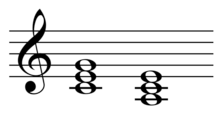Subsidiary chord

Tonic and tonic parallel in C major: CM and Am chords  Play .
Play .
In music and musical analysis, a subsidiary chord is an elaboration of a principal harmonic chord in a chord progression.
If the principal chord (X) is partially replaced by the subsidiary (Y), there are three possible positions - beginning, middle, and end - for the subsidiary:[1]
- X–Y
- Y–X
- X–Y–X

Modulation with subsidiary chord (in blue).[2]  Play
Play
For example, a subsidiary chord in a modulation.
A subsidiary chord may be a chord with related function and/or sharing pitches, for example in E major, C♯m (C♯-E-G♯) as a subsidiary for E (E-G♯-B), which share two of three pitches and are related as tonic parallel (vi) and tonic (I).
See also
Further reading
- Van der Merwe (2005), p. 428.
Sources
- ↑ van der Merwe, Peter (2005). Roots of the Classical: The Popular Origins of Western Music, p.501. ISBN 0-19-816647-8.
- ↑ Becker, Julius (1845). A concise treatise on harmony, p.17. Ewer & Co.
This article is issued from Wikipedia - version of the 6/10/2014. The text is available under the Creative Commons Attribution/Share Alike but additional terms may apply for the media files.